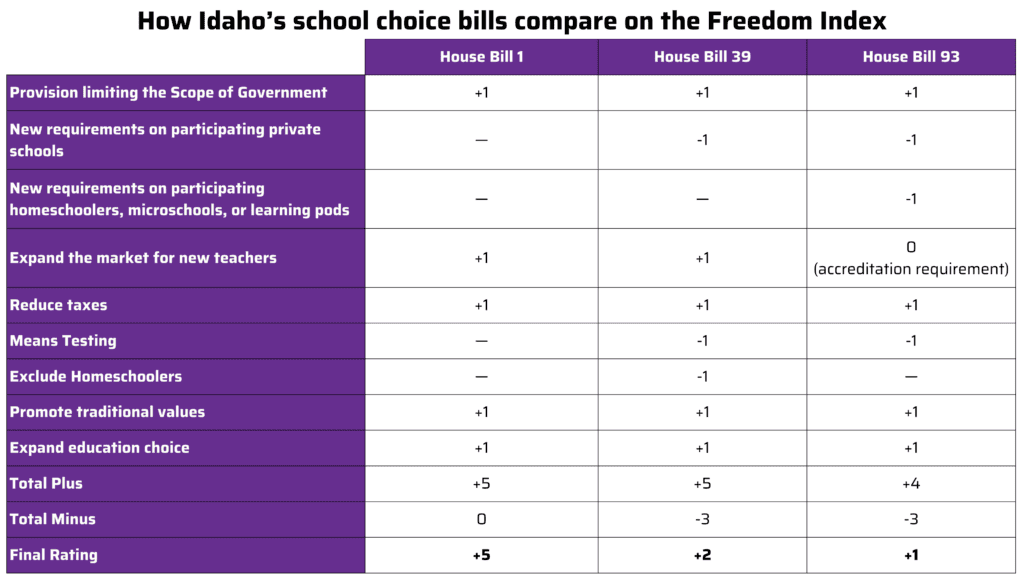


How do legislators decide which way to cast their votes on many of the 600+ bills introduced each session? Or, stated differently, with 105 legislators and 86% of them Republicans, you might expect voting patterns to reflect party lines. But they don’t. We see some bills that are non-controversial pass easily with no opposition, but often “controversial” bills like House Bill 93 for school choice show a different pattern. Democrats vote no as a block and are joined by more left-leaning Republicans in opposition. What drives that final decision? Is it constituents, “outside” interest groups, government agency advocacy, the governor’s wishes, or contract lobbyists? The answer is some combination of all of the above. Into that maelstrom, the Idaho Freedom Foundation (IFF) injects the Freedom and Spending Indices.
Each bill is presented to the relevant committee by the bill’s sponsor, generally another legislator. The committee hearing process favors the legislator presenting the proposed legislation. They get virtually unlimited time to present their case, while the general public gets 2-3 minutes to testify for or against the bill. But then the presenting legislator gets to close the testimony, which means they get the last word. Of course, lobbyists have access to legislators before the bill actually gets a hearing, as they often work to draft legislation. What’s interesting is that much of the advocacy is done behind the scenes, in personal meetings.
IFF rates policy and spending bills using two separate indices. I won’t review the metrics in this article, but you can review them here.
Every year that I have been with IFF, since my first session in 2015, our Index ratings have pleased some constituencies and upset others. Legislators, of course, but also lobbyists and even members of the public. Occasionally, we get kudos because we rate some bills positively, but generally, those go unmentioned. In fact, our positive ratings often facilitate a bill's passage (not that we are seeking credit). It is when we rate a bill negatively that the legislator or interest group decries the index.
Conversely, when I meet many ordinary Idahoans who come to the Capitol for hearings and various meetings, after a brief introduction, many of them comment on how much they appreciate IFF’s index rating system. Invariably, they tell me that it is their window into how their elected representatives are actually voting. Because what elected official, specifically the 86% who are Republicans, wants to be seen as anything other than a “conservative” if he or she is representing a Republican constituency? It is this discernment added by the Freedom Index that adds value.
You see, almost all of the animosity directed towards the indices is not from Democrats. In fact, a few of them have told me that they see scoring low as a badge of honor. It is the moderate and leftist Republicans that criticize the indices most vehemently. Why? Because it shows how much their voting aligns with Democrats, and they would rather their constituents not see that. They will claim that they are being bullied or that the index is used as a tool of intimidation. But what they really want to avoid is “pattern recognition,” meaning how their voting patterns often mirror Democrats on tough votes.
Republicans who champion the Second Amendment but then vote for the same spending bills as Democrats don’t want that pattern to be revealed the way our indices do. When IFF rates about 300 policy and spending bills, the patterns emerge. This is real transparency and provides actual accountability. There is no other mechanism to see these patterns because the Legislature’s data on bills requires a painstaking review and tally of every vote by opening each bill listing, which is not easy or efficient.
And then there is the sheer volume of bills. You see, over the last five sessions, 2020 through 2024, an average of 672 bills, resolutions, proclamations, and memorials were introduced each year. Sessions have averaged 85 days over that period (excluding 2021 when the Legislature avoided adjourning to prevent unwanted COVID actions by the governor). So, that is about eight pieces of legislation to absorb per day. However, that doesn’t tell the whole story. Legislation comes in a big wave starting about February, and then the bills taken up on the floor stack up as you can see here in the House and Senate floor reading calendars.
Now, mind you, there are numerous pieces of legislation that get drafted that are not introduced (about 1,144 items per session, including changes and amendments). And of the aforementioned 672 pieces of legislation introduced, an average of 342 passed both houses — about half. That sure sounds like a lot of legislation to pay attention to, doesn’t it?
IFF rates drafts once they get printed and become bills with an assigned bill number. Since we rate around 300 bills during a session, we can’t be considered a special interest group but rather a general interest group. So, our advocacy using our rating system is the product of a lot of work, not special access. Anyone could do what we do if they had the time and the talent. But nobody else has stepped up.
Now, let’s get specific about some of the ratings that people have questioned.
As of Feb. 17, 2025, IFF had rated 193 bills, resolutions, and memorials. 124 of those, or 64%, have been rated neutrally or positively. I mention this because contrary to thoughts in some quarters, we are not against everything.
House Bill 93, the education tax credit bill heading to the Governor’s desk, passed the House on a 42-28 vote and the Senate 20-15. So, in the House, 69% of Republicans voted yes, and all Democrats voted no. In the Senate, 69% of the Republicans voted yes, and all Democrats voted no. No “pattern” here. House Bill 93 was the third iteration of three similar education tax credit bills. House Bills 1, 39, and 93 were, respectively, rated plus five, plus two, and finally, plus one. Please review the matrix below to understand what changed and how that affected our ratings.

We don’t claim that our ratings are perfect, but we believe they are a unique and valuable product for legislators to sift through a large volume of legislation and for the general public to see behavioral voting patterns at the Idaho Legislature.
If leadership wanted to reduce the influence of the Freedom Index and Spending Index, it would be better served by changing the legislative process to create a budget session (two-year budget) and a policy-oriented session the following year. Legislators would have more time to spend digesting the budget and policy legislation separately. Scapegoating IFF due to the compressed legislative process, which gives our ratings even more value, is misdirected bitterness.

